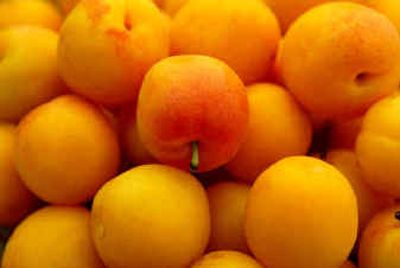Plum-apricot cross enjoys sweet success

BOISE – Oblivious to the fruit and berry juice already staining his happy face, 2-year-old Chayton Aumeier bites into a juicy plumcot, its tart, apricotlike skin blending its perfume into the sweet, plumlike pulp within.
“I tasted them, and I had to come back,” said Chayton’s mom, Jennifer Aumeier, as the youngster meandered in happy circles with his fruit. “They are good, nice and tangy. They’re like the perfect mix in between apricot and plum, I think.”
The plumcot, which has been drawing lots of attention at farmers markets in the Boise area, is a simple cross between the plum and the apricot, 50-50. That’s not to be confused with the pluot, a complex cross that’s 86 percent plum, or the aprium, which is more heavily apricot.
Greenleaf, Idaho, farmer Steve Harris of Shiloh Fruits has been having surprising success growing plumcots, which are mostly grown in California but have proved difficult to “set” there due to a lack of cold winters. Southern Idaho’s chilly winters, warm springs and hot summers have proved a good match for the fruit when frost doesn’t intervene.
Harris tried growing plumcots just for something interesting and different, starting off small in 1997 with just 40 trees. “We got ‘em into production, and we couldn’t supply the demand,” he said. In 2002, he planted another 300 trees.
“It’s got a sweet meat and a tart skin, a combination, so the flavors are kind of changing in your mouth as you eat,” Harris said. “It has the meat of a plum, so it stays firmer than the apricot, doesn’t mush up in the bag.”
The first plumcot was developed nearly a century ago by famed plant researcher Luther Burbank, and it was hailed as an innovation. However, Burbank’s plumcot had a drawback – it didn’t taste good.
Zaiger Genetics in California, a small, family-owned firm, which has developed many of the most popular varieties of hybrid fruits in recent decades, came out with a better plumcot a few years ago, though it hasn’t been as popular as some other varieties, such as super-sweet pluots.
“They’re pretty incredibly flavored fruit,” said Ed Laivo, marketing director for Dave Wilson Nursery in California. The Wilson nursery licenses the Zaiger varieties, all of which are developed through traditional hybrid techniques and without genetic engineering.
Harris, whose Flavorella-variety plumcots are certified organic, sells his unusual fruit mainly at farmers’ markets and some grocery stores in the Boise area. They’re harvested in mid-July, and this year brought a good harvest.
“When we sample ‘em out, 90 percent of ‘em go ‘Wow, this is incredible,’ ” Harris said. “Probably 7 percent are going to go, ‘Eeeuw, this is terrible.’ “
Only a tiny number – he estimates 3 percent – are neutral.
Harris said his brother-in-law, who doesn’t like the plumcot’s tanginess, tells people, “Taste this. It’ll reach out and grab you.”
Harris opted to try the plumcot rather than the pluot mainly because, years earlier, his granddad had pulled out the plum trees on the family orchard, but left the apricots. When Harris asked why, the answer was that the plums didn’t sell. Pluots need plum trees to pollinate them. But plumcots are pollinated by apricot trees.
“I know the apricots are going,” Harris said, so he went with plumcots.
Most of the people lining up at Harris’ booth at the downtown Boise farmers’ market on a recent Saturday had never heard of plumcots.
“It’s pretty good,” said Jerry Anooshian after his first taste. “They’re actually very delicious. I like the flavor.”
The line of customers never seemed to go away. “It’s been pretty steady, pretty much all day long,” Harris said.
Harris also raises several varieties of honey-sweet peaches, along with apricots, pears, nectarines and, his farm’s mainstay, apples.
“We do a better job of getting plumcots than we do apricots, by just a little bit,” he said.
BJ Thurlby, president of the Washington State Fruit Commission, said about 200 acres of pluots are being raised commercially in Washington, and they’re widely available in grocery stores. But he said he hasn’t seen any plumcots yet.
“People learn how to crossbreed and out comes something that’s unique and yummy,” Thurlby said. “As long as there’s a consumer there that’s looking for something new, different and healthy, with a good eating experience attached to it, people will try it.”
Essie Fallahi, a professor and director of pomology – the science of fruit crops – for the University of Idaho Extension, said he’s been testing lots of varieties of peaches, pluots and plumcots, and all seem well-suited to Idaho’s growing conditions. “These are all new and very attractive,” Fallahi said. “People are reacting positively to that.”
Laivo, at the California nursery, said, “If the pluots are confusing and the apriums are confusing, hold on, because we’re now getting ready to introduce the Peacotum – that’s a peach-plum-apricot cross, and they are to die for. And then we have another one called the Nectaplum, that is a nectarine-plum cross. It’s a white-fleshed nectarine with a purple skin that has a plum aftertaste that tastes like wine.”